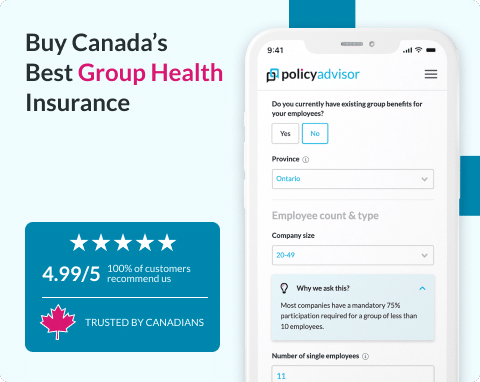- Employment Insurance (EI) provides temporary financial assistance to eligible workers
- The Canada Pension Plan (CPP) and Quebec Pension Plan (QPP) are mandatory retirement savings programs
- Workers’ Compensation Insurance offers financial support for work-related injuries and illnesses
- Paid statutory holidays and vacation leave entitlements vary by province
- Employers are not required to provide private health insurance but may offer supplementary coverage
- What are the mandatory benefits in Canada?
- CPP and QPP Contributions for 2025
- How much is CPP pay per month?
- What are the statutory holidays in Canada?
- What are the rules for vacation pay in Canada?
- Can you take maternity and paternal leave in Canada?
- What is the sick leave rule in Canada?
- Frequently asked questions
Employee benefits play an important role to ensure financial stability and job security in Canada’s workforce. Group benefits are categorized into mandatory benefits (those required by law) and optional/supplementary benefits, which employers may choose to offer voluntarily to enhance employee well-being.
In this article, we’ll take you through the mandatory employee benefits in Canada that employers must provide to comply with federal and provincial laws.
What are the mandatory benefits in Canada?
In Canada, certain employee benefits are legally required under federal and provincial employment laws.
The mandatory benefits that employers must provide employees with are:
- Employment Insurance (EI): A federal program that provides temporary financial assistance to employees who are unable to work due to specific circumstances
- Canada Pension Plan (CPP) and Quebec Pension Plan (QPP): The CPP and QPP are mandatory retirement savings programs that provides retirement, disability, and survivor benefits
- Workers’ Compensation Insurance: a type of social insurance designed to provide financial assistance and support services to employees who suffer work-related injuries or illnesses
- Paid holidays and vacation benefits
- Maternity, parental, and sick leave
Employers who fail to provide these benefits may face legal consequences, including fines and penalties.
CPP and QPP Contributions for 2025
| Category | CPP Contribution Rate | CPP Maximum Contribution | QPP Contribution Rate | QPP Maximum Contribution |
| Employees & employers | 5.95% each (total 11.9%) | $4,034.10 each | 6.4% each (total 12.8%) | $4,563.20 each |
| Self-employed individuals | 11.9% | $8,068.20 | 12.8% | $9,126.40 |
| Second additional contributions (for earnings between $71,300 and $81,200) | 4.00% each (8.00% for self-employed) | $396.00 (employee/employer) / $792.00 (self-employed) | 4.00% each (8.00% for self-employed) | $396.00 (employee/employer) / $792.00 (self-employed) |
Source: Government of Canada
How much is CPP pay per month?
The average monthly CPP retirement pension at age 65 is $808.14, while the maximum payment amount in 2025 is $1,433.00.
| Type of pension or benefit | Average amount for new beneficiaries (October 2024) | Maximum payment amount (2025) |
| Retirement pension (at age 65) | $808.14 | $1,433.00 |
| Post-retirement benefit (at age 65) | $16.01 | $47.82 |
| Disability benefit | $1,538.67 | $1,673.24 |
| Post-retirement disability benefit | $583.32 | $598.49 |
| Survivor’s pension – younger than 65 | $527.91 | $770.88 |
| Survivor’s pension – 65 and older | $325.64 | $859.80 |
| Children of disabled or deceased contributors benefit – under age 18 | $294.12 | $301.77 |
| Children of disabled or deceased contributors benefit – full-time student | $294.12 | $301.77 |
| Children of disabled or deceased contributors benefit – part-time student | N/A | $150.89 |
| Death benefit (one-time payment) | $2,499.54 | $2,500.00 |
| Combined survivor’s and retirement pension (at age 65) | $1,017.67 | $1,449.53 |
| Combined survivor’s pension and disability benefit | $1,293.81 | $1,683.57 |
Source: Government of Canada
Employer contributions to mandatory benefits in Canada
Employers in Canada are required to contribute to several mandatory benefits, which vary by province. These contributions are essential for employee welfare and impact overall compensation costs.
| Benefit | Employer contribution rate | Maximum annual contribution (2025) |
| Employment Insurance (EI) | 1.4 times the employee’s EI contribution | $1,508.47 per employee |
| Canada Pension Plan (CPP) (except Quebec) | 5.95% of pensionable earnings | $3,867.50 per employee |
| Quebec Pension Plan (QPP) (for Quebec employees) | 6.40% of pensionable earnings | $4,282.40 per employee |
| Workers’ Compensation | Varies by province & industry | Based on assessed risk class |
| Quebec Parental Insurance Plan (QPIP) (Quebec only) | 0.692% of insurable earnings | $607.35 per employee |
What are the statutory holidays in Canada?
Paid public holidays are mandatory across Canada to ensure that employees receive a day off with pay. While statutory holidays may vary by province, common mandatory holidays include:
| Holiday | Date (2025) | Day of the week | Provinces observed |
| New Year’s Day | January 1 | Wednesday | All provinces & territories |
| Good Friday | April 18 | Friday | All provinces & territories |
| Easter Sunday | April 20 | Sunday | Not a statutory holiday, but widely observed |
| Victoria Day | May 19 | Monday | All provinces except QC |
| Canada Day | July 1 | Tuesday | All provinces & territories |
| Civic Holiday (varies by province) | August 4 | Monday | BC, AB, SK, ON, NB, NT, NU (Not statutory in all) |
| Labour Day | September 1 | Monday | All provinces & territories |
| National Day for Truth and Reconciliation | September 30 | Tuesday | BC, MB, NS, PEI, NT, NU, YT, Federal employees |
| Thanksgiving Day | October 13 | Monday | All provinces except NB, NS, PEI, NL |
| Remembrance Day | November 11 | Tuesday | BC, AB, SK, MB, NB, NS, PEI, NL, NT, NU, YT (Not ON & QC) |
| Christmas Day | December 25 | Thursday | All provinces & territories |
| Boxing Day | December 26 | Friday | ON, NB, NL, NT, NU (Not statutory in all) |
What are the rules for vacation pay in Canada?
In Canada, vacation benefits vary based on employment standards set by each province and territory. The following table gives an overview of the provincial vacation entitlement in Canada:
| Province | Years of Service (YoS) | Minimum Vacation Entitlement (MVE) |
| Alberta | Up to 5 years
At 5 years |
2 weeks
3 weeks |
| British Columbia | Up to 5 years
At 5 years |
2 weeks
3 weeks |
| Manitoba | Up to 5 years
At 5 years |
2 weeks
3 weeks |
| New Brunswick | Up to 8 years
At 8 years |
2 weeks
3 weeks |
| Newfoundland & Labrador | Up to 15 years
At 15 years |
2 weeks
3 weeks |
| Nova Scotia | Up to 9 years
At 9 years |
2 weeks
3 weeks |
| Ontario | Up to 5 years / At 5 years | 2 weeks
3 weeks |
| Prince Edward Island | Up to 8 years
At 8 years |
2 weeks
3 weeks |
| Saskatchewan | Up to 10 years
At 10 years |
3 weeks
4 weeks |
| Québec | Up to 3 years
At 3 years |
2 weeks
3 weeks |
Can you take maternity and paternal leave in Canada?
Yes, employees are entitled to 17 weeks of maternity leave, which can begin up to 13 weeks before the expected delivery date. For adoptive parents, 63 weeks of parental leave is available. This leave can be taken by one parent or shared between both parents.
What is the sick leave rule in Canada?
Different provinces have varying rules when it comes to sick leave. Some of the key features of sick leave as an employee benefit are:
- Employees receive a fixed number of sick days at the start of each year, regardless of when they join
- Sick leave is not pro-rated; employees who start mid-year still receive the full entitlement
- Unused sick leave cannot be cashed out or carried over to the following year
Sick leave entitlement for each province in Canada
| Province | Eligibility | Sick leave entitlement |
| Alberta | NA | No provincial requirement |
| British Columbia | After 90 days of employment | 5 paid days, 3 unpaid days |
| Manitoba | NA | No provincial requirement |
| New Brunswick | No waiting period | 5 unpaid days |
| Newfoundland and Labrador | After 30 days of employment | 7 unpaid days |
| Nova Scotia | No waiting period | 3 unpaid days |
| Ontario | After 2 weeks of employment | 3 unpaid days |
| Prince Edward Island | After 3 months of employment | 3 unpaid days |
| After 5 years of continuous employment | 1 paid day | |
| Saskatchewan | After 13 weeks of employment | 12 unpaid days |
| Québec | After 3 months of employment | 2 paid days |
What are the optional employee benefits in Canada?
Optional employee benefits include group health benefits, group registered retirement savings plans (RRSPs), health spending accounts (HSAs), disability insurance (DI), critical illness coverage, life insurance, additional paid days off, wellness programs, transportation allowances, and cash bonuses.
Optional group health benefits may also include other supplemental benefits such as:
- Stock options
- Retirement savings programs
- Employee training and development
- Flexible work schedules
- Remote work
- Compassionate care leave
- Indigenous employee leave
- Childcare benefits
Frequently Asked Questions
Are independent contractors entitled to mandatory benefits?
No, independent contractors in Canada are not entitled to mandatory employee benefits because they are considered self-employed and do not fall under the same legal framework as employees. The Employment Standards Act outlines benefits and protections for employees, but independent contractors must arrange their own pension contributions, insurance coverage, and other financial protections. However, some industries may offer independent workers the option to participate in group benefit plans.
How do employers contribute to mandatory benefits?
Employers must contribute to mandatory programs like CPP/QPP and EI, with contribution rates set by the government. For CPP/QPP, both employers and employees contribute equally, while for EI, employers contribute 1.4 times the amount deducted from an employee’s paycheck. Employers must also pay into workers’ compensation programs, which vary by province. Staying compliant with these contribution requirements is essential to avoid penalties and ensure employee benefits are properly funded.
What happens if an employer fails to provide mandatory benefits?
Failure to provide legally required benefits can lead to significant financial and legal consequences. Employers who fail to deduct or contribute to CPP, EI, or workers’ compensation insurance may face fines, interest charges, or even legal action from regulatory authorities. Employees who are denied mandatory benefits can file complaints with the appropriate government agencies, potentially leading to audits and enforcement measures. Non-compliance can also harm an employer’s reputation and impact employee retention.
Can employers offer additional supplementary benefits beyond the mandatory ones?
Yes, many employers choose to offer additional benefits to attract and retain talent. Common supplementary benefits include extended health coverage, dental and vision care, life insurance, disability insurance, and wellness programs. While not legally required, these benefits improve job satisfaction and help employers remain competitive in the job market. Offering supplementary benefits can also contribute to a healthier, more engaged workforce.
Do employers have to provide health insurance as part of mandatory benefits?
Employers are not required to offer private health insurance, but they must ensure employees have access to provincial healthcare coverage, which covers essential medical services. Many employers voluntarily provide supplementary health insurance to help employees with expenses not covered by the public system, such as prescription drugs, dental care, and paramedical services. While not mandated by law, employer-sponsored health plans can enhance employee well-being and job satisfaction.
Mandatory group benefits in Canada ensure employees receive essential financial protection and job security. These include Employment Insurance (EI), Canada Pension Plan (CPP)/Quebec Pension Plan (QPP), workers’ compensation, paid holidays, and various leave entitlements. Employers who fail to provide these benefits may face legal penalties. While health insurance is not mandatory, many employers offer supplementary benefits to attract and retain talent.


 1-888-601-9980
1-888-601-9980



